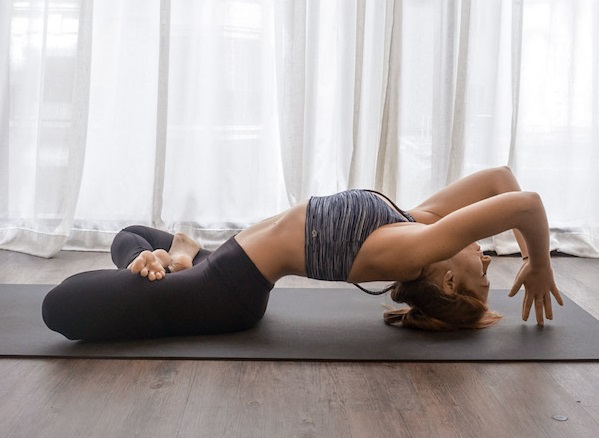
For those of us starting out in the fitness industry and those seasoned veterans who’ve been teaching for years, it’s common knowledge that the first few months, and even the first year, are the hardest.
We’re constantly swirled with the ups and downs that come with being a new teacher and it can be a time of both intense questioning and sporadic self-assurance. But, as with most moments of conflicting emotions, these times are often the most profound.
Speaking only from my own experience as a new teacher, I’ve had more ups and downs in the past few months than I have in any other career. I used to work in a corporate job and yes, it was high stress at times and challenging in many ways, but the experiences I’ve had as a new yoga teacher have been on a whole new scale.
During the past three months, I’ve had an extra amount of “free-time” induced by my new work schedule, which has in turn allowed me to do a bit of self-reflecting/worth-measuring/career-analyzing.
This has brought me to the below list of realizations that, although not revolutionary, are important to share with other new teachers or anyone putting themselves out there and trying something new.
1. Not everyone is going to like your teaching style and that’s okay.
In fact, it’s a beautiful thing! This is something I’m still continuing to work through as a new teacher. During my YTT, one of the first tips my teachers shared was that if you’re becoming a yoga teacher to be liked by everyone, then get out now.
Just like in life, not everyone is going to like you and the same thing applies to teaching. Of course, you want everyone in your class to have a good experience because they’ve invested time and money to be there. And it’s normal to want your classroom to fill up with more and more students in order to seek out the gratification of popularity. But it’s not always going to happen and probably not at first. In fact, some of my own favorite teachers weren’t my favorite in the beginning.
With new students, you’re unfamiliar and they may not trust you right from the start; they may even still be unsure about yoga. They also, simply put, just might not like your style. But you’ll soon find out that what’s most important is the student who comes back—the one who jives with your style and finds something inspiring in you.
There are so many different types of teachers and that’s what makes yoga so powerful. There is a teacher out there for everyone and as long as you’re sharing your true self, your students will come. And they’ll be more open to receiving what you have to give.
2. Don’t try to teach what you’re not confident in.
This is a big one. I think as new teachers, we’re heavily influenced by other instructors in the industry, especially the ones we look up to and who pack studios to the brim. It’s normal to want to jump into creative sequencing right from the get-go or incorporate props into our fitness-based classes. And this is absolutely wonderful if you know what you’re doing and it’s coming from a genuine place. But lack of confidence shows and trying to be too technical too soon can really hurt you.
There’s so much to be learned in the first year of teaching and so much of the learning has more to do with finding your voice, your teaching style, and your overall confidence. Speaking from experience, I’ve tried to over-complicate my classes in the hopes that they would be interesting and impress the students. But I wasn’t comfortable teaching them. And this is where our credibility lies—in our confidence.
No one wants to take instruction and advice from someone who is unsure. So in the beginning, even if all you’re teaching is simple Sun Salutations or basic muscle toning exercises, that’s okay. The most simple of classes can be the most effective; and your personality shines best when you’re sure of yourself.
3. Feedback is your new best friend.
Ask for it and welcome it often. I’ve always appreciated receiving feedback, but to be honest, as a teacher, it feels so much more personal—especially when it’s not positive. But it’s not often you’ll get properly evaluated as a teacher, and because everyone has a different style of teaching, it can be difficult to acquire legitimate, constructive feedback. Therefore, I try to always ask at the end of class for people to come speak with me about anything, whether it be good or bad.
During the first few weeks of asking, I didn’t have many volunteers. But as the weeks have passed, I get someone who volunteers to speak up at least a few times a week. It’s been amazing and, to my surprise, far from negative. I’ve gotten comments about projecting my voice more when I have music playing and about potentially slowing down my beginners class. Both of these tips were small but important pieces of feedback.
This, in turn, has opened up so much more communication with my students and I find they feel safer and more open with me. They’ve now begun to tell me more about themselves and what they’ve enjoyed about my classes, which allows me to plan better for future classes. So don’t be afraid of the negative, because it’s necessary and may not be as bad as you think.
4. See everyone as a potential mentor—both students and teachers.
One of my favorite aspects of teaching thus far is seeing how many different types of students come to class. Now, obviously we’re all different, but it’s so humbling to see students ranging from young, professional athletes to men and women in their 70s and 80s all in the same room. It’s also taught me so much about how everyone gets something unique from each class, and just because there are various levels together doesn’t mean your class isn’t going to work.
I’ve found that my students mentor me as much as my teachers by simply letting me in on their stories. Each new student I get to know brings something special to class and that creates such a wonderful learning environment. And that’s when you know that yoga is doing its work.
5. Never stop thinking of yourself as a student, first and foremost.
The best teachers continue to learn and grow amongst their students. Directly after graduating from my YTT, I couldn’t help but analyze all the classes I took, breaking them down in my head and critiquing them as if they were something to be judged. But doing that is so beside the point of doing yoga. I soon remembered what my teachers had said about simultaneously being a teacher and a student: it’s going to unavoidably change your perspective. But it’s how you use that perspective that’s important.
Every practice is different and you’ll quickly lose your student mindset if you always have a teacher’s brain. I’ve realized how necessary it is to try to take the best aspects of the teacher and student brain and meld them together when I’m practicing someone else’s class. If you focus on always learning, both what you like and dislike, then you’ll be able to turn every class into a positive experience and not only remain a student, but also be able to share your continued experiences in your own classes.
It’s also common to lose your own practice once you start teaching and this is the biggest downfall of teaching. But how can you share something you don’t do? How can you connect with people when you’re not experiencing what they are experiencing? I’ve had to really make sure that I’m not spending all my time thinking about what I have to teach and putting my own self-practice and exploration to the side.
I don’t doubt that in the next year I’ll have even more discoveries as a teacher and in fact, I’m sure of it. But I also think that some struggles never go away, we just learn how to accept and embrace them as part of life.
~
~
Author: Krista Shogren
Image: Author’s own
Editor: Nicole Cameron
Copy Editor: Catherine Monkman


 Share on bsky
Share on bsky




Read 0 comments and reply